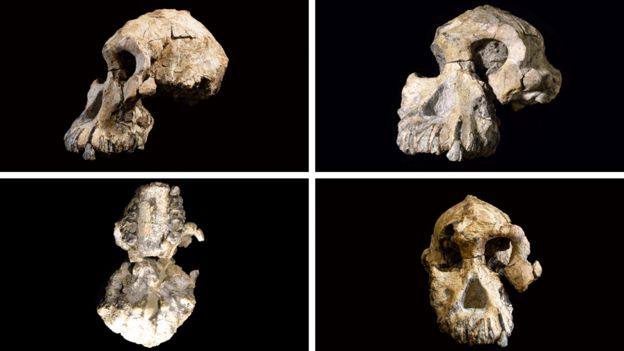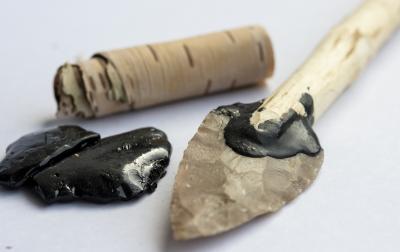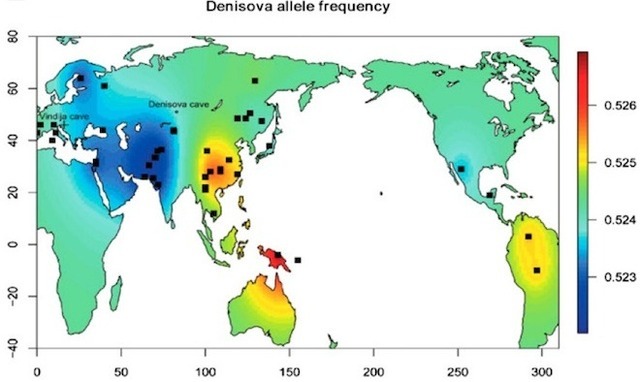Scientists to grow 'mini-brains' using Neanderthal DNAGeneticists hope comparing prehistoric and modern biology will help them understand what makes humans uniqueHannah DevlinLast modified on Fri 11 May 2018 17.12 EDT
Kennis models of Homo sapiens (left) and a Neanderthal man. Photograph: Kevin Webb/NHM Image Resources/The Natural History Museum, London
Scientists are preparing to create “miniature brains” that have been genetically engineered to contain Neanderthal DNA, in an unprecedented attempt to understand how humans differ from our closest relatives.
In the next few months the small blobs of tissue, known as brain organoids, will be grown from human stem cells that have been edited to contain “Neanderthalised” versions of several genes.
The lentil-sized organoids, which are incapable of thoughts or feelings, replicate some of the basic structures of an adult brain. They could demonstrate for the first time if there were meaningful differences between human and Neanderthal brain biology.
“Neanderthals are the closest relatives to everyday humans, so if we should define ourselves as a group or a species it is really them that we should compare ourselves to,” said Prof Svante Pääbo, director of the genetics department at the Max Planck Institute for Evolutionary Anthropology in Leipzig, Germany, where the experiments are being performed.
Pääbo previously led the successful international effort to crack the Neanderthal genome, and his lab is now focused on bringing Neanderthal traits back to life in the laboratory through sophisticated gene-editing techniques.
The lab has already inserted Neanderthal genes for craniofacial development into mice (heavy-browed rodents are not anticipated), and Neanderthal pain perception genes into frogs’ eggs, which could hint at whether they had a different pain threshold to humans. Now the lab is turning its attention to the brain.
“We’re seeing if we can find basic differences in how nerve cells function that may be a basis for why humans seem to be cognitively so special,” said Pääbo.
The research comes as the longstanding stereotype of Neanderthals as gormless and thuggish is being rewritten by emerging evidence that they buried their dead, produced cave art and had brains that were larger than our own.
Svante Pääbo
Prof Svante Pääbo, director of evolutionary genetics at the Max Planck Institute for Evolutionary Anthropology. Photograph: Christian Jungeblodt
In the basement beneath Pääbo’s office, scientists are working to extract DNA – the code of life – from ancient human and animal fossils excavated at sites across the world. The team’s success relies on taking obsessive precautions against contamination: a speck of dust floating in through a window can contain more DNA than the few milligrams of powdered ancient bone under analysis. Researchers shower and don spacesuit-style uniforms before entering rooms kept sterile by UV lights and a sophisticated air filtration system.
It was under these stringent working conditions in 2010 that his team reassembled the code of the Neanderthal genome from heavily degraded samples taken from four females who lived in Europe tens of thousands of years ago.
The genome revealed Neanderthals interbred with our ancestors – and successfully enough that all non-Africans today carry 1-4% of Neanderthal DNA. And since people acquired slightly different genes, collectively about a third of the Neanderthal genome is still floating around in modern populations.
However, there are also genetic dead zones: large stretches of the Neanderthal genome that nobody inherited, possibly because they conferred disadvantages to health, fertility, cognition or physical appearance.
Quick guide
Evolutionary timeline
“We want to know whether among those things, is there something hiding there that really sets us apart?” Pääbo said. “Is there a biological basis for why modern humans went on to become millions and eventually billions of people, spread across the world and have culture?”
It is not certain that the contrasting fates of the two species are linked to differences in cognition, but Pääbo said: “It’s tempting to think that, yes.”
The latest work focuses on differences in three genes known to be crucial for brain development. Using the editing technique Crispr, changes have been introduced into human stem cells to make them closer to Neanderthal versions.
The stem cells are coaxed using chemical triggers to become neurons, which spontaneously clump together and self-organise into miniature brain-like structures that grow to a few millimetres in diameter. The lack of any sensory input means the internal wiring is haphazard and varies from one blob to the next.
“You start the organoid growing and leave it for nine months and see what happens,” said Gray Camp, a group leader at the institute who is overseeing the organoid experiments. “You don’t get a well-formed human brain at all, but you see multiple regions have kind of formed; you can study the synapses and electrical activity and early developmental differences.”
The scientists will compare the Neanderthalised organoids and the fully human ones to assess the speed at which the stem cells divide, develop and organise into three-dimensional brain structures and whether the brain cells wire up differently.
“A dream result would be that the [genetic] changes make for longer or more branched neuronal outgrowth,” said Pääbo. “One would say it would be a biological basis for why our brain would function differently.”
The work won’t reveal which species is “smarter”, but could hint at differences in the ability to plan, socialise and use language.
The lab is also looking at how Neanderthal genes that are commonly found in the DNA of people with European and Asian ancestry influence brain development. By growing organoids from cells taken from living people and looking at how the Neanderthal genes switch on and off, the team can see whether a person’s brain development is subtly influenced by their ancient Neanderthal ancestry.
“We can regrow your Neanderthal brain,” said Camp. “We can monitor that and resurrect the functionality of those neanderthal genes.”
Guardian graphic
The team are not the first to contemplate resurrecting Neanderthal biology. The Harvard professor George Church previously suggested that a cloned Neanderthal baby could be created if an “adventurous female human” were prepared to act as a surrogate. Such a scenario, Pääbo counters, is not only ethically unpalatable but unachievable with today’s technology, which allows for only a handful of genetic edits at a time rather than the 30,000 required for fully Neanderthal tissue.
Pääbo said he finds comments like Church’s frustrating because “then other people like me have to look like the boring, non-visionary guy, saying it’s not possible and think about the ethics.”
Do blobs of brain come with their own ethical considerations? “Yes, at some point one can of course ask, when does a developing brain become an individual? But that is far into the future.”
Modern humans and Neanderthals split into separate lineages around 400,000 years ago, with our ancestors remaining in Africa and the Neanderthals moving north into Europe. About 60,000 years ago, the archaeological record reveals, there was a mass migration of modern humans out of Africa that brought the two species face-to-face once more. The revelation that Neanderthals interbred with humans and were far more sophisticated than previously thought has led some to suggest the two lineages should be merged into a single species, but Pääbo and others disagree.
“Yes, there’s growing evidence that Neanderthals, particularly towards the end of their history, did some form of art,” he said. “But if I’m a little mean, I would say they did some art but it was very modern art because I can’t see what it depicts.”
And there is no evidence of Neanderthals having set out to explore the world’s oceans, as humans did at least 100,000 years ago, a feat that perhaps has as much to do with mindset as with being inventive enough to build a boat.
“It is very risky to set out into the Pacific and look for something when you don’t know there’s something out there,” Pääbo said. “Neanderthals were reasonable, like other mammals. They didn’t go out into the ocean without seeing anything on the other side. To me, the biggest question in human history is, why did we become this crazy?”
Since you’re here …
… we have a small favour to ask. More people are reading the Guardian than ever but advertising revenues across the media are falling fast. And unlike many news organisations, we haven’t put up a paywall – we want to keep our journalism as open as we can. So you can see why we need to ask for your help. The Guardian’s independent, investigative journalism takes a lot of time, money and hard work to produce. But we do it because we believe our perspective matters – because it might well be your perspective, too.
https://www.theguardian.com/science/201 ... erthal-dna 







